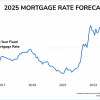
It seems almost nothing has gone right for mortgage rates since mid-2022.
Case in point: the spread between the 10-year Treasury bond rate and 30-year mortgage rate.
It’s normal for mortgage rates to be higher than the 10-year U.S. Treasury bond yield. But since 2022, mortgage rates have been way higher.
Mortgage Rates Are Usually 1.72% Above the 10-Year Treasury
Between 2005 and 2019, the 30-year fixed mortgage rate has averaged 1.72% above the 10-year Treasury bond rate.
This is normal. Investors need a higher interest rate to invest in mortgages. They are inherently more risky than a bond issued by the U.S. government.
U.S. government debt is viewed as essentially risk-free.
So when accepting debt from U.S. homeowners – who can lose their jobs, have medical emergencies, or simply pay off their mortgages at any time – investors want to earn a higher interest rate for the trouble.
In normal times, investors are perfectly happy to buy mortgage debt at about 1.72% above U.S. Treasury debt.
But the times are not normal.
How High is the 10-Year/Mortage Rate Spread?
As of January 18, 2024, the spread between the 10-year Treasury and 30-year mortgage was 2.45%
This is a big improvement from the 2.9% spread as recently as October 2023. The 10-year Treasury yield was 4.89% at that time. This equalled a recent mortgage rate high of 7.79% according to Freddie Mac.
Today, Freddie Mac reports a 6.6% mortgage rate, thanks to economic data that points to lower inflation. The Fed has also indicated potential rate cuts in the future.
Still, spreads are high. But what if they weren't?
What Would Mortgage Rates Be With Normal Spreads?
Most homebuyers and refinancing homeowners are shocked at what mortgage rates should be right now.
Let’s see what happens when we add the current 10-year Treasury yield and a typical mortgage rate spread.
Oct. 2023 | Current Spread | If Normal Spread | |
10-Year Treasury | 4.89% | 4.14% | 4.14% |
Spread | 2.9% | 2.46% | 1.72% |
30-Year Mortgage | 7.79% | 6.60% | 5.86% |
You read that right: mortgage rates would be in the high 5s if we had normal spreads.
To put it in real dollars, the current high spread is costing homebuyers $168 more per month on a $350,000 mortgage.
So what’s going on?
Why Are Spreads So Large?
There are at least two factors contributing to large spreads between 10-year Treasury and mortgage rates, according to The Brookings Institution, an independent research organization.
Prepayment risk: Investors are concerned homeowners will refinance out of their high-rate mortgages the minute rates drop, removing future interest income
Low demand: There’s less demand for mortgage-related assets on the secondary market
What does all that mean?
Prepayment risk
Currently, investors in mortgage assets demand a high premium.
It’s the same reason you might loan out money for a month at 30% annual interest but might be okay with 10% on a five-year loan.
Investors want to collect as much interest as they can upfront because they think those loans will be paid off as soon as rates drop.
So high rates are, in effect, feeding on themselves: the higher rates go, the more investors assume people will refinance soon, driving up rates further.
Low demand
In the Fed's inflation fight, it removed itself as a buyer of mortgage-backed securities (MBS). They were the biggest buyer.
Plus, according to Brookings, “Private investors in MBS have readjusted portfolios in response to an increase in interest rates…demand for MBS has remained cool since then.”
In short, there are fewer buyers, and those buyers are buying less. This leads to lower demand and higher rates to keep attracting investors.
When Will Mortgage Spreads and Rates Drop?
It seems the only thing that can bring down rates is, well, lower rates.
With low rates, investors would not be as concerned that homeowners would refinance, leaving them with no financial return. That could attract more investors, increase demand, and bring down rates further.
But what about the initial rate drop to get things started? Some things that could do it are lower inflation readings, signs that the economy will cool, or an all-out recession.
While some options aren’t ideal, we could see dramatically lower rates in short order if they happen.
In fact, we could see very low rates soon if one key recession predictor proves true again: the inverted yield curve that points to a recession in the spring or summer of 2024.
The hard part will be getting lower rates without bringing the entire economy down with them. All things considered, that is more painful than high mortgage rates.




